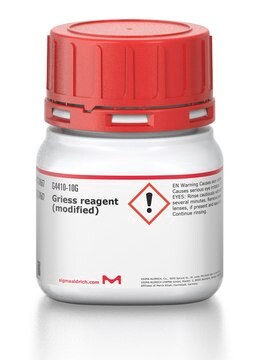482655
Nitric Oxide Assay Kit, Fluorometric
Sinonimo/i:
NO, Nitric Oxide
About This Item
Prodotti consigliati
impiego
sufficient for 192-288 tests
Livello qualitativo
Confezionamento
pkg of 1 96-well plate(s)
Produttore/marchio commerciale
Calbiochem®
Condizioni di stoccaggio
OK to freeze
input
sample type aqueous solution(s)
Metodo di rivelazione
fluorometric
Temperatura di conservazione
−20°C
Descrizione generale
Componenti
Attenzione
Specifiche
Nota sulla preparazione
Stoccaggio e stabilità
Altre note
Misko, T.P., et al. 1993. Anal. Biochem. 214, 11.
Green, L.C., et al. 1982. Anal. Biochem.126, 131.
Note legali
Avvertenze
Danger
Indicazioni di pericolo
Classi di pericolo
Acute Tox. 3 Oral - Aquatic Acute 1 - Eye Dam. 1 - Met. Corr. 1 - Ox. Liq. 3 - Resp. Sens. 1 - Skin Corr. 1A
Codice della classe di stoccaggio
5.1B - Oxidizing hazardous materials
Certificati d'analisi (COA)
Cerca il Certificati d'analisi (COA) digitando il numero di lotto/batch corrispondente. I numeri di lotto o di batch sono stampati sull'etichetta dei prodotti dopo la parola ‘Lotto’ o ‘Batch’.
Possiedi già questo prodotto?
I documenti relativi ai prodotti acquistati recentemente sono disponibili nell’Archivio dei documenti.
Il team dei nostri ricercatori vanta grande esperienza in tutte le aree della ricerca quali Life Science, scienza dei materiali, sintesi chimica, cromatografia, discipline analitiche, ecc..
Contatta l'Assistenza Tecnica.








